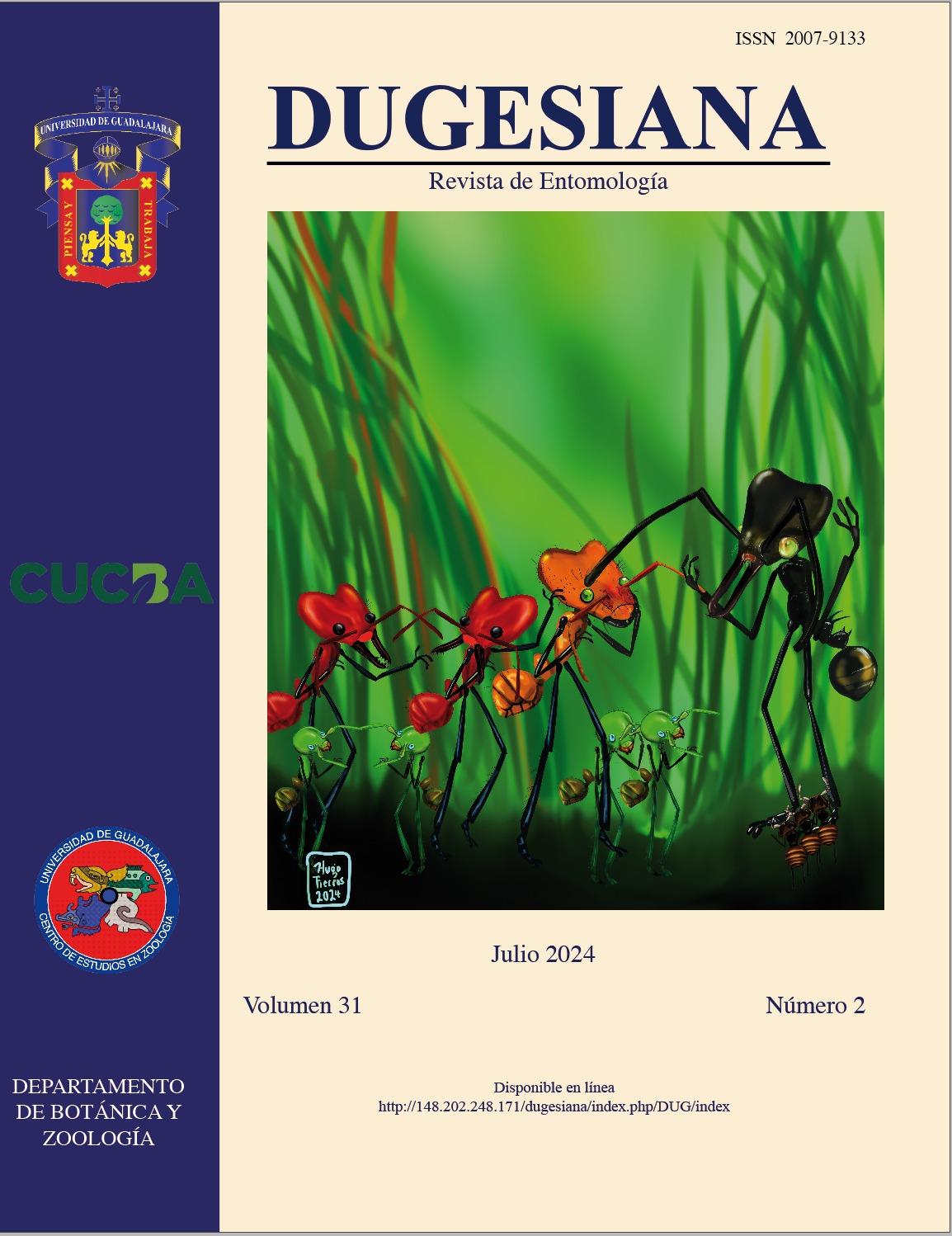Hidden in the cracks, a new species of Scorpion from Michoacan, Mexico (Scorpiones: Vaejovidae)
DOI:
https://doi.org/10.32870/dugesiana.v31i2.7340Palavras-chave:
diversity, endemism, sympatry, lithophilousResumo
A new species of Vaejovis is described for Michoacan, Mexico belonging to the nigrescens/nitidulus group, the less diverse group of species from the genus. This species has a preference for synanthropic environments and inhabits rock walls within the city limits. Additionally, the pictures of the hemispermatophore are presented and characters are named according to new terminology. This species is named honoring Dr. Gabriela Castaño Meneses for her great contributionsto arthropods research in Mexico and the world.Referências
Chávez-Samayoa, F., J.E. Díaz-Plascencia and E. González-Santillán. 2022. Two new species of Vaejovis (Scorpiones: Vaejovidae) belonging to the mexicanus group from Aguascalientes, Mexico, with comments on the homology and function of the hemispermatophore. Zoologischer Anzeiger 298: 148–169. https://doi.org/10.1016/j.jcz.2022.04.005
Contreras-Félix, G.A. and O.F. Francke. 2019. Taxonomic revision of the “mexicanus” group of the genus Vaejovis C.L. Koch, 1836 (Scorpiones: Vaejovidae). Zootaxa,4596(1): 1–100. https://doi.org/10.7550/rmb.37437
Contreras-Félix, G.A., O.F. Francke and R.W. Bryson Jr. 2015. A new species of the “mexicanus” group of the genus Vaejovis C.L. Koch, 1836 from the Mexican stateof Aguascalientes (Scorpiones: Vaejovidae). Zootaxa, 3936(1): 131–140. https://doi.org/10.3958/059.046.0119
González-Santillán, E. and L. Prendini. 2013. Redefinition and generic revision of the North American Vaejovid Scorpion subfamily Syntropinae Kraepelin, 1905, with description of six new genera. Bulletin of the American Museum of Natural History, 380: 1–71. https://doi.org/10.1206/830.1
Loria, S.F. and L. Prendini. 2014. Homology of the lateral eyes of Scorpiones: A six-ocellus model. PloS One, 9(12): e112913. https://doi.org/10.1371/journal.pone.0112913
Prendini, L. 2003. Revision of the genus Liposoma Lawrence, 1928 (Scorpiones: Bothriuridae). Insect Systematics and Evolution, 34(3): 241–264. https://doi.org/10.1163/187631203788964764
Santibáñez-López, C.E. y D.W. Sissom, 2010. A new species of the Vaejovis eusthenura group in Oaxaca, Mexico (Scorpiones: Vaejovidae). Zootaxa, 2493(1): 49–58. 10.11646/ZOOTAXA.2493.1.4
Santibáñez-López, C.E., E. González-Santillán, L. Monod and P. Sharma. 2019. Phylogenomics facilitates stable Scorpion systematics: Reassessing the relationships of Vaejovidae and a new higher-level classification of Scorpiones (Arachnida). Molecular Phylogenetics and Evolution, 135: 22–30. https://doi.org/10.1016/j.ympev.2019.02.021
Sissom, W.D. 1991. Systematic studies on the Nitidulus group of the genus Vaejovis, with description of seven new species (Scorpiones, Vaejovida). The Journal of Arachnology, 19(1):4–28.
Sissom, W.D. and O.F. Francke. 1985. Redescription of some poorly known species of the Nitidulus group of the genus Vaejovis (Scorpiones, Vaejovidae). Journal of Arachnology, 13(2): 243–266.
Soleglad M.E. and V. Fet. 2005. A new scorpion genus (Scorpiones: Vaejovidae) from Mexico. Euscorpius, 24:1–13. https://dx.doi.org/10.18590/euscorpius.2005.vol2005.iss24.1
Stahnke, H.L. 1970. Scorpion nomenclature and mensuration. Entomological News, 81(12): 297–316.
Vachon, M. 1952. Étude sur les Scorpions. Institut Pasteur d’Algérie. Algeria.
Volschenk, E.S. 2005. A new technique for examining surface morphosculpture of Scorpions. Journal of Arachnology, 33(3): 820–825. https://doi.org/10.1636/s03-047.1
Zárate-Gálevez, K. and O. F. Francke. 2009. A new Vaejovis (Scorpiones: Vaejovidae) from Chiapas, México. Zootaxa, 2313(1):61–68. 10.11646/ZOOTAXA.2313.1.3
Downloads
Publicado
Edição
Seção
Licença
1. Política propuesta para revistas que ofrecen acceso abierto
Aquellos autores/as que tengan publicaciones con esta revista, aceptan los términos siguientes:- Los autores/as conservarán sus derechos de autor y garantizarán a la revista el derecho de primera publicación de su obra, el cuál estará simultáneamente sujeto a la Licencia de reconocimiento de Creative Commons que permite a terceros compartir la obra siempre que se indique su autor y su primera publicación esta revista.
- Los autores/as podrán adoptar otros acuerdos de licencia no exclusiva de distribución de la versión de la obra publicada (p. ej.: depositarla en un archivo telemático institucional o publicarla en un volumen monográfico) siempre que se indique la publicación inicial en esta revista.
- Se permite y recomienda a los autores/as difundir su obra a través de Internet (p. ej.: en archivos telemáticos institucionales o en su página web) antes y durante el proceso de envío, lo cual puede producir intercambios interesantes y aumentar las citas de la obra publicada. (Véase El efecto del acceso abierto).
2. Política propuesta para revistas que ofrecen acceso abierto diferido
Aquellos autores/as que tengan publicaciones con esta revista, aceptan los términos siguientes:- Los autores/as conservarán sus derechos de autor y garantizarán a la revista el derecho de primera publicación de su obra [ESPECIFICAR PERIODO DE TIEMPO], el cuál estará simultáneamente sujeto a la Licencia de reconocimiento de Creative Commons que permite a terceros compartir la obra siempre que se indique su autor y su primera publicación esta revista.
- Los autores/as podrán adoptar otros acuerdos de licencia no exclusiva de distribución de la versión de la obra publicada (p. ej.: depositarla en un archivo telemático institucional o publicarla en un volumen monográfico) siempre que se indique la publicación inicial en esta revista.
- Se permite y recomienda a los autores/as difundir su obra a través de Internet (p. ej.: en archivos telemáticos institucionales o en su página web) antes y durante el proceso de envío, lo cual puede producir intercambios interesantes y aumentar las citas de la obra publicada. (Véase El efecto del acceso abierto).




